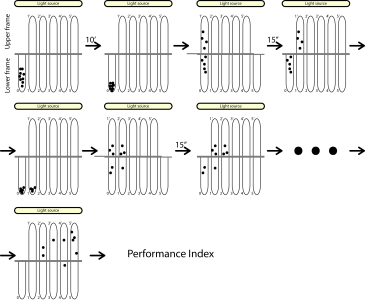We use Benzer’s countercurrent apparatus to assess the phototactic response from flies. Our version of the apparatus has six tubes in the lower frame and 5 in the upper frame (see image).
24h before the experiment, anesthetize 3-6 d old flies under CO2, and clip 2/3 from both wings to half of them. In the same vial, place around 30 flies with clipped wings and another unclipped 30 flies. Let them recover from anaesthesia until experiment begins.
Experiment begins.
- Place the flies in the first tube (0, see figure) and let them adapt for 10 min in the dark. The apparatus has to be horizontal in order to avoid a geotactic component in the response from flies.
- Turn on the light source
- Place the apparatus vertically and tap it gently in order to move all the flies to the bottom of the tube. Immediately, place the apparatus horizontally with the upper frame facing the source of light, and face the tube 0 with the tube 1’ by moving the upper frame to the left. Let it so for 15 sec.
- Move the upper frame to the right in order to prevent the flies from moving from one tube to another.
- Repeat steps 3-4 as many times as tubes in the upper frame you have (5 in our case).
- Count the number of flies with and without wings in each pair of tubes facing each other and in the 0 tube.
- Calculate the Performance Index.
The Preference Index is calculated using the formula:
PI=((#F5×5)+(#F4×4)+(#F3×3)+(#F2×2)+(#F1×1)+(#F0×0))/(#FT )
where #Fn is the number of flies in the tube n (being 0 the initial tube and 5 the last tube), and #FT is the total number of flies. A higher index means a more positive response to light. In each experiment a PI is calculated for the wingless flies and other for the intact flies.

